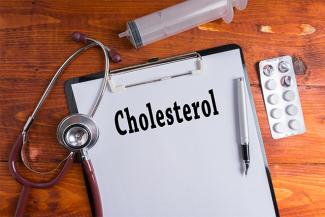
Are eggs off-limits? How to make sense of the numbers on ‘low-cholesterol’ packaged foods? Is extra virgin coconut oil all it is made out to be? These and other questions answered by nutritionist Kohila Govindaraju
Does our body need cholesterol?
The surprising answer is Yes! Cholesterol, a fatty substance that circulates in the blood is an important component of human cells. It is often viewed as an all-out villain, but our body needs some amount of cholesterol to function. Cholesterol plays a major role in the production of vitamin D, bile acids that aid in digestion, absorption of vitamins and in the formation of hormones like estrogen, progesterone and testosterone.
Our body produces about 75% of cholesterol and we achieve the remaining 25% through food.
Cholesterol floats around your blood in two different forms: Low-density lipoprotein (LDL) and High-density lipoprotein (HDL) cholesterol.
Good cholesterol, bad cholesterol
Everyone should know their LDL and HDL levels because they provide you with a more specific estimate of the risk of developing arterial blockages. People with elevated levels of LDL are more likely to suffer from heart attacks. Every 10mg increase in LDL per deciliter (dL) of blood, the risk of heart attack increases by almost 20%.
LDL cholesterol in higher levels along with other substances can deposit as plaque within the walls of the arteries, causing these pipes to get narrower and less flexible. This condition is called “atherosclerosis”. If a clot forms, it will block the narrowed artery, resulting in a heart attack or stroke. It is apparent that as your blood cholesterol rises, your risk for heart diseases also increases. High blood pressure, diabetes and smoking will further increase the risk.
Higher level of HDL, the good cholesterol, will lower the risk of cardiac events. HDL helps remove LDL cholesterol from the arteries.
Controlling high cholesterol
Regular exercise and the right type of diet will help increase HDL cholesterol and reduce LDL cholesterol at the same time.
Exercise: Start your aerobic exercise now and within 2 months you will see an increase in HDL by 5%. Any exercise that increases your heart rate, like brisk walking, running, cycling, swimming, dancing will help increase the HDL in the blood. Enjoy your brisk exercise every day, 30 minutes, to reap the benefit of HDL.
Diet to manage cholesterol
Diet don’ts: Saturated foods are not only high in calories but also tend to increase the blood LDL cholesterol.
Related Reading: Top Foods To Lower Cholesterol
How much fat intake is acceptable and of what kind?
Dietary Reference Intake (DRI) for fat for adults (19 yrs and older) is minimum 3 TBSP and maximum 5 TBSP. This accounts for 20-30% of calories for a 2000-calorie diet. Of this, the American Heart Association recommends 5-6% of daily calories from saturated fat. This means that for 2,000 calories a day, you can have only 13g (120 calories) from saturated fat.
So, limit the consumption of foods high in saturated fat, trans-fat and cholesterol, like:
- Desiccated coconut, coconut oil, palm oil, cheese, cocoa butter that are high in saturated fats
The latest health fad is coconut oil. It is supposed to help weight loss, various illnesses and even Alzheimer’s. There is not much clinical evidence regarding these claims. In fact, remember that coconut oil is high in saturated fat, along with a blend of short and medium chain fatty acids. One tablespoon of coconut oil contains 117 calories, 12 g saturated fat. The daily allowance of saturated fat is 13g. Even extra virgin coconut oil (derived from fresh coconut flesh), which retains its antioxidants when compared to refined coconut oil (derived from the dried coconut flesh), is still high in saturated fat and not advised for daily/everyday cooking.
- Margarine, a partially hydrogenated fat, is high in trans-fat that elevates LDL cholesterol and lowers HDL cholesterol. If you are eating margarine, use the liquid variety with 0g trans-fat.
- Butter, animal fats (beef fat), lard (pork fat, duck fat, goose fat), beef, lamb, pork, chicken with skin, whole milk are high in saturated fats and cholesterol as well. Peanut butter contains hydrogenated oil.
- Baked foods are high in saturated fats and trans-fats. Some food labels may show low in cholesterol. But they may contain more trans-fat and saturated fat. So, read the food label before you add on to your cart. It is good to choose a product with less than 10g of saturated fats and less than 0.5g-1g of trans fat/serving. It is obvious that if you eat more than one serving, you will reach your daily limit of these fats. The daily limit of saturated fat is 13g (120 calories) and trans fat is less than 2g (less than 20 calories). [Food labels will list the measurement of trans fat only if there is 0.5g or more per serving. So, if the label shows “0” trans fat that means the product might still have some trans fat, but less than 0.5g!]
- Contrary to what’s long been said, eating an egg a day is fine.
Diet dos
- Swap high saturated fats for their lower-fat counterparts, like skimmed milk, lean meat, chicken without skin, and fish. You can have a fatty fish like salmon, steamed or baked (85g/3 oz) twice a week, for it is rich in omega fats. It’s better to stay off the coconut milk when making fish curries.
- Use sunflower, safflower, canola, olive oil for cooking. Extra virgin olive oil, drizzled on salads, will help control blood glucose and cholesterol after a meal.
- Eat the following:
- Whole grains
- Lean meat, poultry without skin, fish
- Nuts & seeds
- Fruits & vegetables
- Low-fat dairy products
References:






